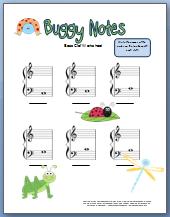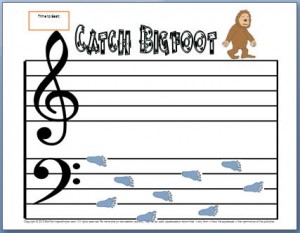You can help kids become pros at reading and playing those tricky notes of the bass clef.
Kids need extra practice with bass clef notes
 Kids always seem less familiar with the notes from the bass staff. This is likely because the melody is typically in the treble range and they can get by, playing simple songs, once they learn the treble notes.
Kids always seem less familiar with the notes from the bass staff. This is likely because the melody is typically in the treble range and they can get by, playing simple songs, once they learn the treble notes.
In addition, it takes a lot of effort to learn to read music notation and some kids start giving up after they’ve mastered their first notes. They expect reading music to come easily, and don’t realize that it takes just as much effort to learn the low notes as it did when they were first beginning to learn the high notes. Kids get frustrated when it takes longer than they wish, and many kids just stop trying.
Why kids need those low notes
While it’s true that you can fumble your way through simple songs without learning the low notes, the music in the method books, as well as the music from pop songs that kids want to learn, will get more difficult and require that you be familiar with the full range of notes.
If a child hasn’t mastered the notes before they start learning more difficult songs, the child will have a very difficult time in his music studies. Learning new songs will be frustrating. Teachers know what this looks like–week after week the child attempts to play the same song. Very little progress is made at home because the child can only figure out which notes to play by counting lines and spaces. This process takes too long and is tedious and boring, so the child is not at all interested in practicing the song. But the child isn’t the only one who’s bored. The teacher tires of working on the same piece for weeks on end and seeing very little progress.
The very best thing to do in this situation is to slow down or stop learning new pieces and focus entirely on helping the student learn to read the bass clef. Once a child knows her notes, she becomes more confident. Sight reading new pieces is easier. The child makes faster progress through her method book. And because she can see and feel her progress, she gets even more excited about her studies. This creates a positive cycle of the child becoming more confident, having more desire to work hard, seeing more results, and as a result becoming even more confident.
Finding good bass clef worksheets for kids
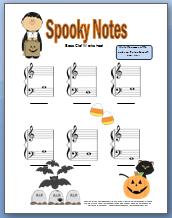
If your students (or your child, if you’re a parent) participates in music theory testing, you’ll want to make sure he’s prepared for what he’ll see on the exam. Although a plain black and white worksheet isn’t as eye-catching as a colorful one, it’s a good idea to occasionally use these. A child will become confused and scared if he sits down in front of an exam and sees material that’s presented in a foreign way. You want your student to be confident when he tests, so use plain black and white worksheets from time to time.
Examples of fun printable worksheet for bass clef notes
Buggy Notes Bass Clef Worksheet
This worksheet has a bug theme that kids love. You can access and print it by clicking the link.
Print Bass Buggy Notes worksheet for free.
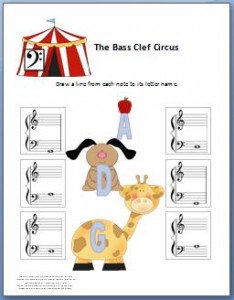
Bass Clef Circus Worksheet
I really like this worksheet because of the teaching technique that accompanies it. When working with young children I first present the bottom, middle and top line notes. You can learn more about this technique and The Bass Clef Circus by clicking the link.
Print Bass Clef Circus worksheet for free.
Bigfoot Bass Clef Activity
If you’re working with older piano students, be sure to give this activity a try. You’ve got to be quick at naming your notes if you’re going to catch Bigfoot. You can read how to use this worksheet by visiting the Catch Bigfoot post.
Print Bigfoot worksheet for free.
Other methods for teaching the bass clef notes to kids
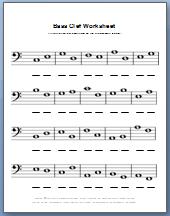
Note reading games are especially effective because kids who dread drills can get the same amount of practice, but enjoy the experience because its offered through playing a game. Games can help you drill concepts, but do it in a fun way.
Flash cards drills are a little more tedious than games, but very effective. It’s a good idea to ask the child to name the note and play it on her instrument each time you hold up a card. You can make flash card drills more interesting by turning them into a timed challenge or a creative game.
Composition activities are an excellent way to give kids practice with notes because the child gets to experiment with sounds, choose notes, and then write those notes on the staff. You can tailor your composition activity to exactly fit the learning needs of the child. For example, if you’re trying to help him master bass clef notes C,D,E,F,G you can ask him to compose a song using only those notes and require that he use each note at least one time.
Need help with the high notes? Visit this post about treble clef worksheets.
